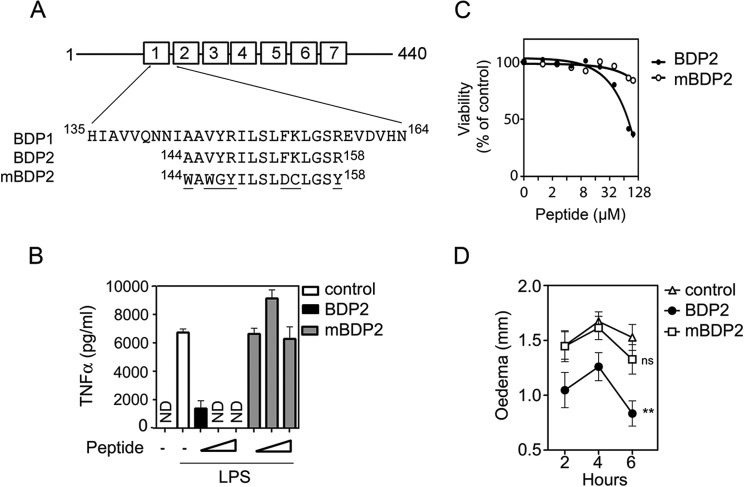FIGURE 7.
A, schematic representation of the BDP1, BDP2, and mutated BDP2 (mBDP2) BCL-3-derived peptide sequences with corresponding murine BCL-3 amino acid positions indicated and mutations underlined. B, RAW 264.7 cells were left untreated or pre-treated for 2 h with increasing concentrations (10 μm-40 μm) of either BDP2 or mBDP2 peptide before stimulation with 100 ng/ml of LPS. Supernatants were harvested 4 h after stimulation and the concentration of TNFα was determined by ELISA. ND, not detected. C, RAW 264.7 cells were treated with increasing concentrations of BDP2 or mBDP2 peptides (0–100 μm) for 6 h and viability was assessed by WST-1 assay. Viability is expressed as a percentage of the control (no peptide) absorbance A450 nm to A630 nm and data shown are representative of 3 independent experiments. Peptide concentration is presented on a Log2 scale. D, PBS (Control), BDP2 (10 mg/kg), and mBDP2 (10 mg/kg) were administered intraperitoneally 1 h before edema induction. 2% λ-carrageenan was administered by subplantar injection into the hind paw, and edema was evaluated as the difference between basal paw thickness and paw thickness measured at 2, 4, and 6 h following carrageenan injection. Data shown are mean ± S.E. of individual mice, n = 15/group. Statistical significance between control and treatment groups was determined by two-way analysis of variance with Bonferroni post hoc analysis. NS, not significant and p < 0.01 (**).

